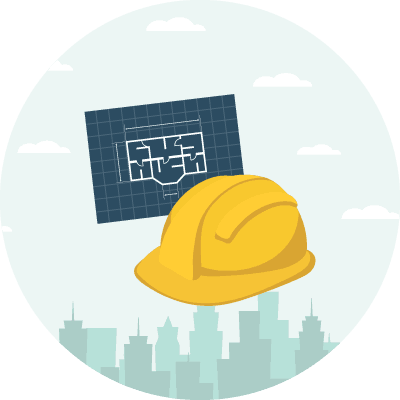What Is Land Entitlement?
REtipster does not provide legal advice. The information in this article can be impacted by many unique variables. Always consult with a qualified legal professional before taking action.
Land Entitlement Explained
Entitlement is generally a three-step process; Planning (where the property gets entitled), Engineering (when grading permits and utilities are approved), and Building and Safety (where the building permits are issued). Most conventional financiers will require these approvals before advancing any funds for further construction and development.
Entitlement is the critical first step in the development of any large parcel of land, and it ultimately determines the permissible uses for the property and to what extent it can be developed. Depending on the local governing body and the professionals involved in the entitlement process (surveyors, attorneys, etc), entitling a property can be a slow, challenging, and complex, process.
Pro Tip: One helpful resource that can help determine which states will be easiest to process entitlements is the CATO Insitute Land User Freedom Index, which ranks all 50 states in the U.S. by land-use freedom.
Entitlements determine many different things about how the subject property will be used, including,
- The building type
- Number of buildings
- Uses of each building
- Building setback requirements
- Architecture
- Landscaping
- Protected tree species removal
- Encroachments
When land goes through the entitlement process, it is done in accordance with the subject property’s highest and best use in mind and in conjunction with the municipal zoning and planning department.
When a property is entitled, the owner or developer effectively has an agreement with the governing municipality to determine how property will be developed, what will be constructed on the property (if anything), and how the land will be used in the future.
This agreement with the local governing body often adds value to the property because once a property is entitled, the approved use or development is “vested”, which means the right has been granted to the property owner and cannot be revoked without the owner’s permission. This vesting provides certainty and that certainty has a value attached to it in the eyes of the developer.
When a property is unentitled, the owner or developer will not be able to proceed with their development plans and will likely face consequences if they do so without the blessing of the local governing body.
Land Entitlement Examples
There are many situations where entitlements could be required before the owner can start making changes to their property.
Road Approvals
If the property does not have public or private road access to their property, a neighboring property owner may need to grant easement access so a road can be added to the subject property. In many cases, the county road commission will also have to be involved to approve the plans. One of the common conditions of approval for entitlement also often includes roadway dedication.
For example, if the ultimate roadway width in the general plan is 52 feet, each half section of the road will be 26 feet. If the existing roadway is 44 feet wide, that means the road will have to be expanded 8 feet wider. A landowner will often be required to dedicate their share of that width along the frontage of their property. Since 8 feet translates to 4 feet on each side, the landowner may lose 4 feet of their property for the length of the total frontage. While this may not be required immediately, the landowner will likely be required to give an irrevocable dedication, which means at any point the municipality needs it, they can take it.
Utility Approvals
If basic utilities aren’t available to the subject property, the owner may need to obtain approval from the local municipality to get both wet and dry utility lines run to their property. Most jurisdictions won’t approve utility meters of connections without a land-use approval in place.
For example, you typically cannot get a water meter attached to a vacant parcel without the jurisdiction being aware of what that water is being used for. They will require some kind of entitlement, even if it’s just for a single-family home.
Landscaping
For some landscaping projects that involve extensive changes to the property (e.g. – adding a pond, waterfall or re-shaping the land), the local planning department may need to approve such a drastic change to the aesthetic of the property. This is especially true with commercial and multi-family properties.
Conditional Use Permits
In cases where the use of a property falls outside of the conditions of the property’s allowed uses or if there will be alterations to the property that will have a perceived negative impact on its surroundings (increased noise, light, or air pollution), a conditional use permit may be required to allow for this use.
Zoning Changes
A property’s zoning determines what can and cannot be constructed on the property and what activities are acceptable. Zoning affects not just a single property, but usually an entire neighborhood. If a property is not currently zoned for the owner’s desired use, they can attempt to rezone the property, which is a form of entitlement.
A zoning change is a legislative action that requires a public hearing and approval from both the Planning Commission and City Council. Specific findings must be made, as with all entitlements, to support the rezoning request.
Zoning Variances
In some cases, a property doesn’t necessarily need a zoning change, but the owner wants an exception to the established zoning laws, so they can alter the property in a smaller way. Some examples of this might be building outside of the established setbacks or height restrictions, changing the aesthetic of the building in a way that doesn’t conform to the pre-existing guidelines, adding parking spaces, or accessory buildings that aren’t currently allowed by the zoning restrictions.
Zoning Text Amendment
There are times with changing the zoning or requesting a variance will not yield the landowner’s or the developer’s desired result. In these cases, a zoning text amendment may be the best option.
For example, most zoning codes are permissive in nature meaning that only those land uses listed in the permitted use chart are potentially allowed. If a specific land use is not listed in the zoning code, it will typically be prohibited based on supporting language in the code. In order to get this type of proposed use approved, the landowner or developer will need to add that specific use to the permitted use chart. This is where a zoning text amendment comes into play.
Subdivision Maps
In the most basic sense, subdivisions are requests to split one parcel of land into two or more parcels. This is legally demonstrated by a subdivision map that is typically created by a civil engineer and then recorded at the county recorder’s office. Once recorded, the new lots have been legally created.
Lot Line Adjustment
A Lot Line Adjustment is the process used to change property lines of existing parcels. The process can be used to create the same number or fewer lots than what was previously there. This can be useful when one property owner wishes to purchase a portion of the property adjacent to them.
Minor Use/Minor Conditional Use Permits
Much like a Conditional Use Permit, a Minor Use Permit is required for some land uses that require an added level of review but does not rise to the level of requiring the review of the Planning Commission. Some examples include a martial arts studio or a music instruction use. A Minor Use Permit is sometimes also used for some types of development activity that requires a higher level of review such as a haul route for soil as a result of grading activities.
Architectural Design Review
As the name implies, this type of entitlement is required for the architectural re-facade of typical commercial buildings. However, in some communities, it is also required for the re-facade of residential structures in historical preservation areas for example.
Tree Removal Permits
In many communities, specific tree species are protected from removal or even encroachment into the “protected zone” of the tree which typically is under the tree canopy. Removal of these trees typically requires that any removals be mitigated by replacing the trees on a dollar-for-dollar basis based on tree values established by the International Society of Arboriculture.
Development Review
Also sometimes called a Site Plan Review, a Development Review is required for any kind of vertical development of a project site. It most often applies to multifamily and commercial development but in some jurisdictions, it may also be applied to custom homes. The intent of this process is to review the developer’s proposed project against the development standards that exist within the development code and other planning documents applicable to your project.
What's the Difference Between Zoning and Entitlements?
Zoning is the separation of land within a jurisdiction into districts called zones. Each of these zones will have a designation assigned to them that will be accompanied by a set of regulations that control the types of uses allowed, the intensity of development permitted, and the visual aesthetic associated with said development.
Zoning is generally classified into four broad categories, Agricultural, Residential, Commercial, and Industrial. There are many gradients and combinations of these basic zoning designations that make up the fabric of the developed environment within any community.
An entitlement is a general term used to describe a variety of land use approvals that grant a vested right to the landowner to develop their property. In the most basic sense, zoning, by way of the zoning ordinance, sets the rules in which property is to be developed, and entitlements are property-specific approvals that bring the zoning ordinance to life.
Why Do Entitlements Matter?
From the perspective of residents of a jurisdiction, entitlements matter because they theoretically establish a set of criteria that will ensure orderly development, including the separation of incompatible land uses. For example, placing a residential subdivision next to an auto salvage yard doesn’t constitute good planning and is the primary reason that zoning was created in the first place.
From the perspective of a jurisdiction, entitlements are important because they provide the jurisdiction with the opportunity to conduct a higher level of review with the goal of ensuring that development projects meet the goals, policies, and objectives of the General Plan (aka Comprehensive Plan).
Lastly, from the perspective of the investor or developer, entitlements are important because, with entitlements in place, the landowner now has a vested right that cannot be removed or revoked without the owner’s permission. Once granted and acted on, they cannot be taken away. Another reason that they are important is that entitlements are often (not always) discretionary, meaning that they are approved only at the discretion of the Planning Commission, City Council or similar. That discretion adds risk to the project. Once the entitlements are approved and are in place that entitlement risk is eliminated. In the end, entitlements add certainty and in the world of real estate development, certainty is very valuable.
The Entitlement Process
The entitlement process can be complex and lengthy in many cases, so it’s helpful to have an understanding of what to expect before you get started.
It’s always a good idea to start by reaching out to the planning department within the jurisdiction to clarify their specific process. However, for the purpose of this discussion, below is an outline of what the typical entitlement process looks like.
1. Pre-application Meeting
The pre-application meeting is a great opportunity to identify gaps in your initial due diligence.
It’s highly recommended that you engage in this step prior to closing on any acquisition. You should use due diligence and entitlement contingencies to protect yourself during this period.
2. Application Submittal
It’s very important to submit a complete application. In many states, there is legislation that allows a jurisdiction to stop processing your application in the event that a complete application is not submitted.
For example, in California, the jurisdiction has 30 days to review your application submittal and inform you if it’s complete or not. If you don’t submit a complete application and they wait until day 30 to let you know, you will lose an entire month plus whatever time it takes you to gather the information they are requesting. Not to mention, submitting an incomplete application makes the job of the jurisdiction that much harder and now you’ve cast a bad light on your project making it that much harder to support your proposal. Be professional and you will be treated well.
3. Initial Jurisdiction Review Period
This is the period of time where staff has the first opportunity to review your proposal. It’s important to stay in communication with your planner to make sure they have everything they need to review your request.
4. Initial Comments Provided to the Applicant
Comments will typically be provided in writing but will also include an in-person meeting with various members of staff to review their comments.
Take the opportunity to clearly understand the comments provided and attempt to identify the remedy while you have the right parties in the same room.
5. Applicant Works to Address Those Comments
Applicants typically want to know how long the entitlement process will take. Most jurisdictions have internal timelines that they have put in place to facilitate each step within this process. However, this step is the one that most applicants forget to consider. This step is where your team is addressing the comments provided by staff. It’s important that each member of your team clearly understands the comments provided, but it’s also important that they understand your expectations as far as work product and the timeline for completion.
During this time period, the staff will be waiting for your response. Therefore, the processing of your project is essentially put on pause until you resubmit addressing all of the comments provided.
6. Applicant Resubmits Revised Materials Based on Initial Comments Provided
Similar to when you submitted the initial application package, it’s vitally important that you address each and every one of the comments provided by staff. Failure to do this will result in delays and potentially added professional services costs due to change orders, etc.
7. Secondary Jurisdictional Review Period
This is the stage where staff will expect you to have addressed all of the comments they initially provided.
8. Secondary Comments Provided to the Applicant if Needed, or Draft Conditions of Approval Provided
This is where the process can go a bit sideways and you end up in a constant loop. If you haven’t addressed the comments provided originally, or if there are new comments that have not been addressed, you will have to address those comments in a new submittal. This process will repeat over and over until the comments have been adequately addressed.
9. Project Approved Once Conditions of Approval are Accepted by the Applicant if a Public Hearing Planning Commission Is Not Required
If you’ve addressed all of the comments, the staff will issue conditions of approval. This is a document that verifies the approval of your project subject to specific performance and development standards that are found in the local development ordinance.
If your project requires a public hearing before the Planning Commission and/or City Council, then conditions of approval will not be issued at this time.
10. If a Public Hearing Before the Planning Commission Is Required, it will be Placed on an Upcoming Planning Commission Agenda
If a public hearing is required before the planning commission, you’ll want to make sure your project is placed on the soonest possible date. Try to emphasize the importance of your project because sometimes staff will prioritize some projects over others and if you don’t advocate for your project, they can put your project on the back burner and you can end up waiting for a couple of months just for a hearing date. During that time, nothing will happen to move your project forward.
11. If the project is approved by the Planning Commission, the process is complete. However, the project could be continued to a future Planning Commission hearing so that the applicant can provide more information to the Planning Commission, or the project could be denied. If the project is denied by the Planning Commission, then the applicant can then appeal that decision to the City Council.
If at the public hearing your project is looking like it will be denied, request that it be continued to a date in the future so that you have the opportunity to come back with information that can help your case.
If you do receive a denial make sure you pay attention to the appeal dates. There is typically a specific time period that you have to appeal a decision of the Planning Commission to the City Council.
12. If the project requires City Council approval or if the Planning Commission denial is appealed to City Council, the project will be placed on a future City Council agenda. The City Council’s decision is final unless an applicant decides to pursue legal action against the City.
If for some reason you are denied, it’s important to understand the difference between being denied with prejudice and being denied without prejudice. Simply, being denied with prejudice means that you cannot resubmit the same or similar project to the city within a specified timeframe, typically 1-2 years. Conversely, being denied without prejudice means that you technically can resubmit the very next day. In that circumstance, you are starting from the very beginning. Submitting the same exact project wouldn’t be wise as that project just got approved. You would want to resubmit a project that addresses the concerns provided by the jurisdiction that were unmet and ultimately led to the denial.
What Is Typically Found On A Land Entitlement Submittal Checklist?
Every jurisdiction will have some type of application checklist for obtaining land entitlements.
That checklist tells you exactly what you need to gather in order to submit a complete application.
Those items typically include:
- Application form
- Project description
- Property owner consent affidavit
- Adjacent property mailing addresses in cases where a public hearing is required
- Processing fees
- Onsite parking analysis
- Plan sets including the following as applicable
- Site plan
- Floor plans
- Elevations
- Grading plan
- Landscape and irrigation plan
- Hillside exhibit
- Average slope percentage exhibit
- Rezoning exhibit
How Long Does the Entitlement Process Take?
This is a very important question that should be asked during your initial due diligence or at the pre-application meeting. Unfortunately, the answer does differ from jurisdiction to jurisdiction.
It also depends on the type of entitlement being requested. Something like a Development Review may take 6-8 weeks, while a Conditional Use Permit may take 6-9 months, while a Zone Change may take 12-18 months in some cases.
The ultimate timeline for project approval will also be dependent on you and your team’s ability to address comments and concerns provided by staff in a quick and efficient manner. It’s essentially like a game of tennis, in that you always want to put the ball in their court.
What Are The Typical Costs Associated With Land Entitlements?
The typical costs associated with land entitlements include the following:
- Entitlement application fees
- Professional service fees (Architects, Engineers, etc.)
- Duplication fees for the creation of plan sets
The actual dollar amount varies by jurisdiction and by project type. For example, a Conditional Use Permit may have a fee of $350 in one jurisdiction and $7,000 in another although there tends to be more consistency within any one region. Fees within all the jurisdictions of one county will be within a relatively close range of each other.
What Items Or Actions Are Required From The Developer Or Landowner?
The most important item that is needed from the landowner is their authorization to proceed with the entitlement process.
This is usually accomplished via a notarized property owner’s statement that is typically a templated document that is provided by the City. The owner simply signs and notarizes the document and that authorization becomes part of the formal submittal package.
There will typically be a primary point of contact identified on the application. That person may be the property owner but is typically a project manager that works for the property owner directly or indirectly through a development company that has contracted with the landowner.
What Should You Watch Out For In The Entitlement Process?
There are many things that can cause delays in the entitlement process. Here is a list of the most common issues:
- Submitting an incomplete application upon formal submittal;
- Not obtaining property owners authorization prior to formal submittal;
- Not having the right team put together;
- Submitting a formal application without having your team review the proposal against applicable development codes and planning documents;
- Not being responsive to requests for additional information from staff;
- Not addressing initial or secondary comments provided by staff in a timely and effective manner;
- Micromanaging and not letting the team members work within their genius;
- Giving too much of a leash to your team members to where they don’t complete tasks on time;
- Not communicating periodically with planning staff on the status of your project. Don’t rely 100% on what your team is telling you. Go to the source.
Avoid these things at all costs and you’ll give yourself a much better shot at obtaining approval for your project.
Who Has The Final Say In The Granting Of Entitlements?
There are generally three types of authorities that have the ability to approve or deny your project.
- Director: The Planning Director, or similar, will be granted authority to approve lower level entitlements such as Development Reviews, Minor Use Permits, etc. Although the authority is technically the Director’s, you will be working with staff on these types of projects. Staff will ultimately be reviewing and writing all approval documents.
- Planning Commission: The Planning Commission will be the approval authority for those projects that require their approval as described within the zoning ordinance for the jurisdiction. The official approval of the project comes in the form of a resolution signed by each member of the Planning Commission along with an attached set of Conditions of Approval. Entitlements such as Conditional Use Permits will require the approval of the Planning Commission, while entitlements such as a zone change will require that the Planning Commission review the project and then make a recommendation to the City Council as to if the request should be approved or not.
- City Council: The City Council will have the authority to approve requests that are legislative in nature, some of which have not been discussed until now. Examples include zone changes, General Plan amendments, and annexations. The City Council will also hear projects that have been appealed from the Planning Commission.
What Are The Benefits Of Obtaining Land Entitlements?
There are many benefits to obtaining land entitlements and they can be best described by looking at the property from the point of view of the various affected parties.
Landowner: From the perspective of the landowner, once the entitlement is approved, they now have a vested right to develop their property subject to the project description and conditions of approval associated with that entitlement. That vested right cannot be taken away without the landowner’s permission, or if they do not act on that approval within the specified time frame associated with their approval. Typically, a landowner will have 1-2 years to initiate vertical construction. However, most jurisdictions have processes in place to obtain extensions to that 1-2 year time period. With that vested right comes certainty. And in the world of development, certainty translates to value!
Community: With a land entitlement in place, the community will understand how the subject property will be developed. Other benefits could include additional housing supply, increased tax revenue on commercial development, additional parking space, traffic improvements such as signalized intersections and traffic calming devices, and nearly anything else that the developer and the approval authority agree to.

Local Government: There are many benefits that come to the local jurisdiction. Those benefits are then translated to providing enhanced infrastructure such as sewer improvements, community amenities such as park sites, or enhanced street medians as a result of development impact fees. Likewise, commercial developments will add to the sales tax revenues that come to the city and also provide local employment opportunities that reduce residents commute time and reduces environmental impacts due to decreased vehicle miles traveled.
How much value can a property’s value increase just by getting entitlements?
The answer is that it depends. It depends on how much of a discount (if any) the owner purchased the property for originally.
It also depends on the type of entitlement obtained. The more difficult the entitlement process and the higher level of review authority that is required, the more the value of the property will increase as a result.
There is no fixed percentage to use as a rule of thumb. What is important, however, is to establish the value of entitled land from the perspective of a developer and not a recreational land user, for example.
This means you don’t want to use vacant land comps to establish value. You want to start with the end in mind. Establish what the value will be of the finished product, subtract out the cost of development and the profit margin for the developer and you will end up with the residual land value (this is the value of the land once it is entitled). Then you subtract out the costs associated with obtaining those entitlements. That includes fees to the jurisdiction and the cost of professional services. Your profit as a land investor is the residual land value less the cost of entitlements less the acquisition cost.
Below is a basic example for a single-family home. This is a very simplified example used to demonstrate the concept. Figures for the cost to develop and developer profit can be found on the National Association of Home Builders (NAHB) website. The numbers provided are reflective of national averages. Contacting local NAHB offices or local builders is recommended to get more accurate figures for that locality.
| Final sales price | $400,000 (use end product comps, not vacant land) |
| Cost to develop | $240,000 (60%) |
| Developer profit | $48,000 (12%) |
| Residual land value | $112,000 |
| Cost of entitlements | $20,000 (application fees + professional services fees) |
| Raw land acquisition cost | $30,000 |
| Investor profit | $62,000 |
It’s important to note that as you increase the complexity of the entitlement project, the profits begin to increase exponentially as you benefit from fixed professional services costs and the added value of the finished product. The example above is provided for demonstration purposes only.
Who Should Be On Your Entitlement Team?
Much like many other real estate pursuits, entitlements are a team sport. This means the success of your project is often dependent on the quality and reliability of your team.
Most entitlements will require the services of either a project manager and a civil engineer. As you progress in the complexity of entitlements, other team members will include an architect and possibly specialty consultants such as biological resource consultants, traffic consultants, or even railroad consultants if your property is adjacent to a rail line.
The extent of your team is directly related to the complexity of your proposed project. The costs associated with these services vary widely based on locality and the extent of their scope of work. Assessing these costs should be a part of your initial due diligence process.
Reviewed by Mike Marshall of Tolosa Property Group
Takeaways
Land entitlement refers to the legal procedure through which a real estate developer attempts to obtain a permit to develop land. It covers important aspects of land development, including the best use for that parcel of land and the number of buildings, building types, building use, setbacks, and architecture allowed on the entitled land. A land entitled this way or granted permission to be developed by a municipal authority is said to be “vested,” a right that cannot be revoked other than the owner’s express consent.
There are various reasons land entitlement is sought. These reasons include road or utility access, zoning changes, landscaping, lot line adjustments, even tree removals. Depending on the authority that approves the land entitlement (and the projected use and the professionals involved in it), land entitlement is a complex and drawn-out process that is offset only by its potential to increase the value of land. In general, however, the more challenging and the longer the entitlement process, the greater the value added to the property as a result.
Reviewed by Mike Marshall of Tolosa Property Group












